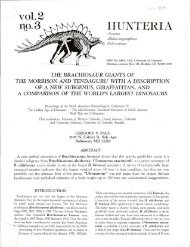THE MANY MYTHS, SOME OLD, SOME NEW, OF ... - Gregory S. Paul
THE MANY MYTHS, SOME OLD, SOME NEW, OF ... - Gregory S. Paul
THE MANY MYTHS, SOME OLD, SOME NEW, OF ... - Gregory S. Paul
You also want an ePaper? Increase the reach of your titles
YUMPU automatically turns print PDFs into web optimized ePapers that Google loves.
DINOSAUR <strong>MYTHS</strong> 89<br />
0.2-0.3. In span, length, bone dimensions, and overall volume, azhdarchids were<br />
much larger than 7.5 m span, 80-120 kg Argentavis. Assuming viable specific<br />
gravities, then a 5.9 m span Pteranodon massed 20-25 kg, and 11 m span Quetzalcoatlus<br />
massed some 250 kg (<strong>Paul</strong>, 1990b). This places large pterosaurs in the<br />
same mass/wingspan-area range as birds, and 12 m class sailplanes and ultralight<br />
aircraft (see Figures 8 and 9).<br />
The thin walled bones of pterosaurs were braced by an extensive set of internal<br />
struts, giving them great strength at low weight (Wellnhofer, 1988).<br />
Figure 8 A two view skeletal restoration of lightly built Pteranodori ingens , based primarily on the skull<br />
and skeleton of USNM 12167 scaled up to fit the complete, 5.9 m span wing of SMM 2085. The<br />
volume/mass ratio of this restoration is similar to earlier estimates. Mass derived from a model and other<br />
means, with a specific gravity of from 0.57 to 0.7 (with the value of the beak assumed to be -0.25) is 20--25<br />
kg. Scale bar equals 1 m.









